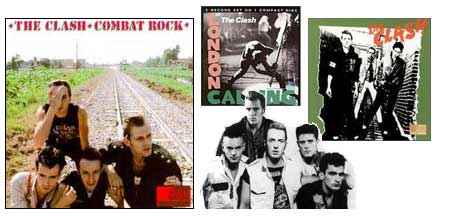The Clash

Synopsis of Pop Music
"The shariff don't like it,
Rockin' the casbah,
Rock the casbah!"
Many pop fans just think of The Clash as a great punk band from the 1970’s. The real truth is that The Clash were one of the best bands of the 1970’s, period. They may have started out as energetic three-chord rockers in the heyday of punk, but they soon grew into an ambitious, multi-talented ensemble that could play everything from rockabilly to rap. Even better, they could combine these many styles into singular hybrids that stood on their own as classics of modern pop music. As a result, they became one of the most influential rock groups of their time.
The members of The Clash were all veterans of London’s music scene by the time they united in 1976. Like many young London musicians, they were put off by the slickness and artificial style of then-current pop music. They followed the lead established by The Sex Pistols and started writing raw, powerful with lyrics that were meaningful and direct. They got a record contract the next year and quickly recorded a self-titled debut. It combined tight, catchy songs with aggressive musicianship on a string of soon-to-be punk rock anthems like “Garageland” and “London’s Burning.” They also extended their skills to reggae with a dazzling cover of “Police and Thieves,” showing they were already more than just a punk band.
The Clash became an overnight hit in the U.K. and put the title band alongside The Sex Pistols at the forefront of punk rock. The album wouldn’t get a U.S. release for two years, but it became an underground hit through import sales. Meanwhile, the group established themselves on both sides of the Atlantic through a series of powerful tours that made lead singer Joe Strummer into one of punk’s top frontmen.
In 1978, The Clash released a new album, Give ‘Em Enough Rope. It gave the group a slicker, hard-rocking sound that was criticized by some punk fans, but it also contained many excellent tunes like the menacing “Tommy Gun” and Mick Jones’ bittersweet memoir “Stay Free.”
1979 was the breakthrough year for The Clash. They toured the U.S. tirelessly and soaked up the many different styles of American music at each stop. In between bouts of touring, they hit the studio to record new songs reflecting all the sounds they were assimilating. They had too much material by the end of the sessions to settle for a single album, so they released a double-album called London Calling. This ambitious classic covered everything from punk (“Clampdown”) to reggae (“Guns Of Brixton”) to dance music (“Train In Vain”) and was immediately hailed as one of the finest achievements of the punk era. Even today, London Calling consistently pops up on lists of the all-time great rock albums.
The one-two punch of tireless touring and a brilliant album like London Calling turned the Clash into stars on an international level. The group took advantage of their good fortune to become even more ambitious in the studio and the result was Sandinista, a triple-record set. It carried the group’s heady combination of styles to a new level with tracks like the rap/disco/punk hybrid “The Magnificent Seven.” Other tracks covered every style from gospel to dub-reggae. Although it didn’t become as praised or successful as London Calling, this album still impresses listeners today with its inventive combinations of sounds and its boundless ambition.
The Clash spent much of 1981 touring and then took their first extended rest in years. In 1982, they returned to the studio to record Combat Rock, the slickest and most radio-friendly album of their career. It soon spawned two major pop hits in “Rock The Casbah,” a danceable slice of new wave, and “Should I Stay Or Should I Go,” a catchy three-chord rocker. The group threw themselves into touring once more, including a stint as the opening act for The Who’s farewell tour in 1983. Mick Jones left the group in 1983 and would go on to form the dance-rock outfit Big Audio Dynamite. Meanwhile, the rest of The Clash soldiered on and produced one more album, Cut The Crap, before disbanding in 1986.
Since the group disbanded, its members have remained active on the music scene. Reunion rumors have abounded throughout the years but have never come to fruition. Regardless, The Clash has already left an indelible mark on the world of pop music. Their legacy continues to live on through reissues, and their influence on modern pop musicians as diverse as Rancid, The Indigo Girls and Ice Cube (all of whom paid homage to The Clash on the 1999 tribute album London’s Burning).
The group most recently returned to public attention through From Here To Eternity, a collection of live tracks recorded between 1977 and 1982. It sold quite well, proving that The Clash’s forward-thinking combination of styles sounds just as good as ever.
Artist Release History
1977 - The Clash [UK version]1978 - Give 'em Enough Rope
1979 - The Clash[US version]
1979 - London Calling
1980 - Sandinista!
1980 - Black Market Clash (compilation)
1982 - Combat Rock
1985 - Cut the Crap
1988 - Story of the Clash, Vol. 1 (compilation)
1989 - Collection
1989 - Crucial Music: The Clash Collection
1990 - 1977 Revisited (compilation)
1991 - Clash on Broadway (compilation)
1991 - The Singles (compilation)
1992 - 12" Mixes (compilation)
1994 - Super Black Market Clash (compilation)
1999 - Live: From Here to Eternity
Pop Sub Categories
rockEssential Music Albums
London Calling (Epic)The Story of the Clash, Vol. 1 (Epic)
Band Members
Joe Strummer lead vocals, rhythm guitarMick Jones vocals, lead guitar
Paul Simonon bass
Terry Chimes (1976-1977) drums
Topper Headon (1977-1982) drums
